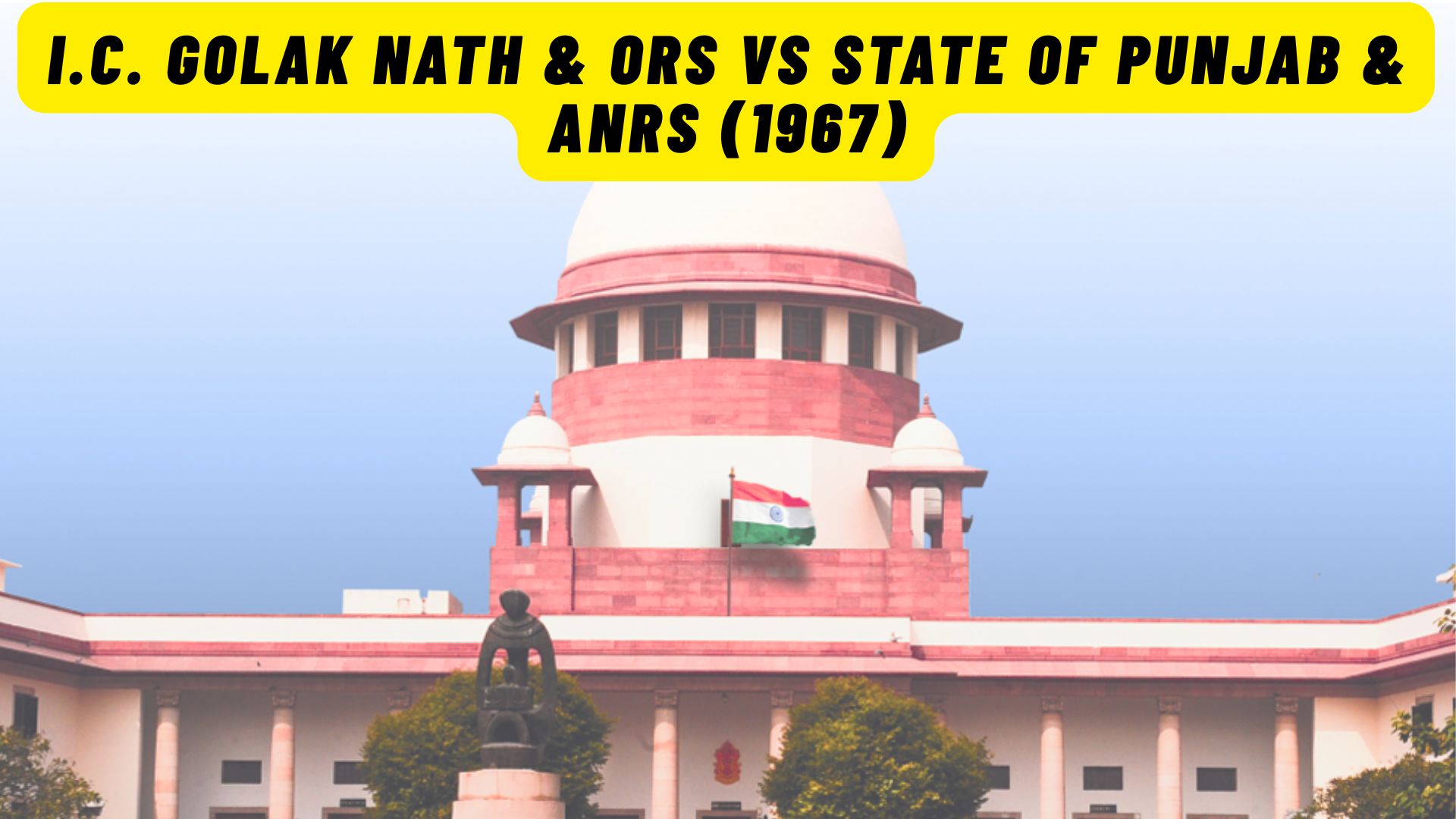
Case Summary: I.C. Golak Nath & Ors vs State of Punjab & Anrs (1967)
Case Stats
(1967) 02 SC CK 0031
Name of the Court: Supreme Court of India
Case No: Writ Petition (Civil) 153 of 1966 (with connected petitions)
Date of Decision: 27-02-1967
Bench: Full Bench (11 Judges)
Hon'ble Judges: K. Subba Rao, C.J.; Vishishtha Bhargava, J.; V. Ramaswami, J.; S. M. Sikri, J.; R. S. Bachawat, J.; M. Hidayatullah, J.; K. N. Wanchoo, J.; J. M. Shelat, J.; J. C. Shah, J.; G. K. Mitter, J.; C. A. Vaidyialingam, J.
Advocates: R. V. S. Mani; S. K. Mehta; K. L. Mehta
Final Decision: Majority 6:5. Earlier views in Shankari Prasad (1951) and Sajjan Singh (1965) overruled; Constitution (17th Amendment) 1964 and prior amendments kept valid by applying 'prospective overruling'.
[Judgment Source] https://www.courtkutchehry.com/Judgement/Search/AdvancedV2?docid=282401
All Citations
AIR 1967 SC 1643; 1967 SCR (2) 762; 1967 INSC 45; (1967) 15 BLJR 818
Facts of the Case
Petitioners (heirs of Henry Golak Nath) challenged the validity of agrarian ceiling laws—notably the Punjab Security of Land Tenures Act, 1953 and the Mysore Land Reforms Act, 1961—on the ground that they violated Articles 14 and 19. The State defended the laws by invoking the Constitution (Seventeenth Amendment) Act, 1964 which expanded Article 31-A and inserted the Acts into the Ninth Schedule (Article 31-B), thereby insulating them from Part III challenges.
Law Points Raised / Issues
1) Is a constitutional amendment ‘law’ within Article 13(2) and hence subject to Part III?
2) Does Article 368 confer constituent power to amend any part of the Constitution, including Fundamental Rights?
3) Are there implied limits on the amending power to protect core constitutional guarantees?
4) Can Articles 31-A/31-B validly place land reform statutes beyond judicial review under Articles 32/226?
5) Should the Court reconsider Shankari Prasad (1951) and Sajjan Singh (1965)?
Acts / Provisions / Articles Referred
Constitution of India, 1950 — Articles 13(2), 14, 19, 31-A, 31-B, 32, 136, 141, 142, 226, 245, 246, 248, 368; Seventh Schedule Entry 97; Article 395 (repeal of GOI Act).
Government of India Act, 1935.
Judgments Referred
• Sri Shankari Prasad Singh Deo v. Union of India (1951)
• Sajjan Singh v. State of Rajasthan (1965)
• A.K. Gopalan v. State of Madras (1950) (on directness test)
• Deep Chand v. State of U.P.; Mahendra Lal Jaini v. State of U.P. (on voidness under Art. 13(2))
Obiter Dicta
The Court endorsed the modern doctrine of ‘prospective overruling’ as suitable for a fast-changing society, clarifying that the Supreme Court can declare law with prospective effect to avoid chaos (Arts. 141 & 142). It cautioned that unchecked amendment power risks eroding liberty and equality, while also noting courts should not presume legislative abuse but must protect fundamental guarantees.
Ratio Decidendi
• Constitutional amendments are ‘law’ for purposes of Article 13(2) and cannot take away or abridge Fundamental Rights.
• Parliament, acting under Article 368, does not have power to amend Part III to curtail Fundamental Rights.
• The Court applies the doctrine of prospective overruling: past constitutional amendments (including the 1st, 4th and 17th) remain valid; henceforth Parliament cannot amend Part III to abridge Fundamental Rights.
Final Ruling
Writs allowed in part. By a 6:5 majority, the Court overruled Shankari Prasad (1951) and Sajjan Singh (1965) on the scope of Article 368. It held that Parliament has no power to amend Part III to abridge/take away Fundamental Rights. Applying prospective overruling, the Court preserved the validity of the Constitution (Seventeenth Amendment) Act, 1964 and prior amendments; the ruling operates prospectively for future amendments.
Relevant Pinpoint References (SCR citations)
• Prospective overruling explained and applied: 1967 SCR (2) 762 at pp. 813–814.
• ‘Law’ in Article 13(2) and relation to constituent power under Article 368: pp. 839 D–F; 772–777 discussion.
• Effect on 17th Amendment & Ninth Schedule; Articles 31-A/31-B and Articles 226/245: pp. 942–945.
• Reversal of Shankari Prasad & Sajjan Singh and prospective effect: pp. 948 D–H.
Summary
Golak Nath (1967) is a landmark decision holding that Parliament cannot use Article 368 to abridge Fundamental Rights; constitutional amendments are ‘law’ under Article 13(2). To avoid unsettling past measures, the Court invoked ‘prospective overruling’, preserving the 1st, 4th and 17th Amendments (including land reform protections via Articles 31-A/31-B and the Ninth Schedule) while prospectively restraining future curtailment of rights. The ruling set the stage for later clarification in Kesavananda Bharati (1973) on the Basic Structure doctrine.
[Judgment Source] https://www.courtkutchehry.com/Judgement/Search/AdvancedV2?docid=282401